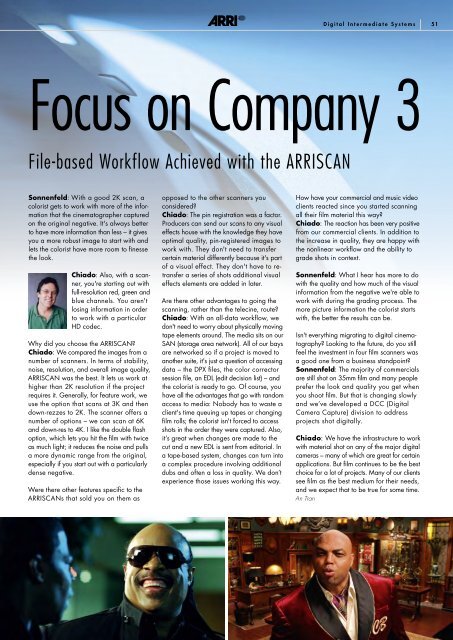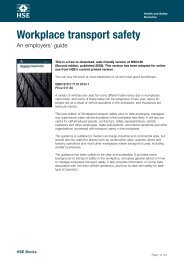Download - Arri
Download - Arri
Download - Arri
Create successful ePaper yourself
Turn your PDF publications into a flip-book with our unique Google optimized e-Paper software.
Focus on Company 3<br />
File-based Workflow Achieved with the ARRISCAN<br />
Sonnenfeld: With a good 2K scan, a<br />
colorist gets to work with more of the information<br />
that the cinematographer captured<br />
on the original negative. It's always better<br />
to have more information than less – it gives<br />
you a more robust image to start with and<br />
lets the colorist have more room to finesse<br />
the look.<br />
Chiado: Also, with a scanner,<br />
you're starting out with<br />
full-resolution red, green and<br />
blue channels. You aren't<br />
losing information in order<br />
to work with a particular<br />
HD codec.<br />
Why did you choose the ARRISCAN?<br />
Chiado: We compared the images from a<br />
number of scanners. In terms of stability,<br />
noise, resolution, and overall image quality,<br />
ARRISCAN was the best. It lets us work at<br />
higher than 2K resolution if the project<br />
requires it. Generally, for feature work, we<br />
use the option that scans at 3K and then<br />
down-rezzes to 2K. The scanner offers a<br />
number of options – we can scan at 6K<br />
and down-res to 4K. I like the double flash<br />
option, which lets you hit the film with twice<br />
as much light; it reduces the noise and pulls<br />
a more dynamic range from the original,<br />
especially if you start out with a particularly<br />
dense negative.<br />
Were there other features specific to the<br />
ARRISCANs that sold you on them as<br />
opposed to the other scanners you<br />
considered?<br />
Chiado: The pin registration was a factor.<br />
Producers can send our scans to any visual<br />
effects house with the knowledge they have<br />
optimal quality, pin-registered images to<br />
work with. They don't need to transfer<br />
certain material differently because it's part<br />
of a visual effect. They don't have to retransfer<br />
a series of shots additional visual<br />
effects elements are added in later.<br />
Are there other advantages to going the<br />
scanning, rather than the telecine, route?<br />
Chiado: With an all-data workflow, we<br />
don't need to worry about physically moving<br />
tape elements around. The media sits on our<br />
SAN (storage area network). All of our bays<br />
are networked so if a project is moved to<br />
another suite, it's just a question of accessing<br />
data – the DPX files, the color corrector<br />
session file, an EDL (edit decision list) – and<br />
the colorist is ready to go. Of course, you<br />
have all the advantages that go with random<br />
access to media: Nobody has to waste a<br />
client's time queuing up tapes or changing<br />
film rolls; the colorist isn't forced to access<br />
shots in the order they were captured. Also,<br />
it’s great when changes are made to the<br />
cut and a new EDL is sent from editorial. In<br />
a tape-based system, changes can turn into<br />
a complex procedure involving additional<br />
dubs and often a loss in quality. We don’t<br />
experience those issues working this way.<br />
D i g i t a l I n t e r m e d i a t e S y s t e m s<br />
How have your commercial and music video<br />
clients reacted since you started scanning<br />
all their film material this way?<br />
Chiado: The reaction has been very positive<br />
from our commercial clients. In addition to<br />
the increase in quality, they are happy with<br />
the nonlinear workflow and the ability to<br />
grade shots in context.<br />
Sonnenfeld: What I hear has more to do<br />
with the quality and how much of the visual<br />
information from the negative we're able to<br />
work with during the grading process. The<br />
more picture information the colorist starts<br />
with, the better the results can be.<br />
Isn't everything migrating to digital cinematography?<br />
Looking to the future, do you still<br />
feel the investment in four film scanners was<br />
a good one from a business standpoint?<br />
Sonnenfeld: The majority of commercials<br />
are still shot on 35mm film and many people<br />
prefer the look and quality you get when<br />
you shoot film. But that is changing slowly<br />
and we’ve developed a DCC (Digital<br />
Camera Capture) division to address<br />
projects shot digitally.<br />
Chiado: We have the infrastructure to work<br />
with material shot on any of the major digital<br />
cameras – many of which are great for certain<br />
applications. But film continues to be the best<br />
choice for a lot of projects. Many of our clients<br />
see film as the best medium for their needs,<br />
and we expect that to be true for some time.<br />
An Tran<br />
51
















